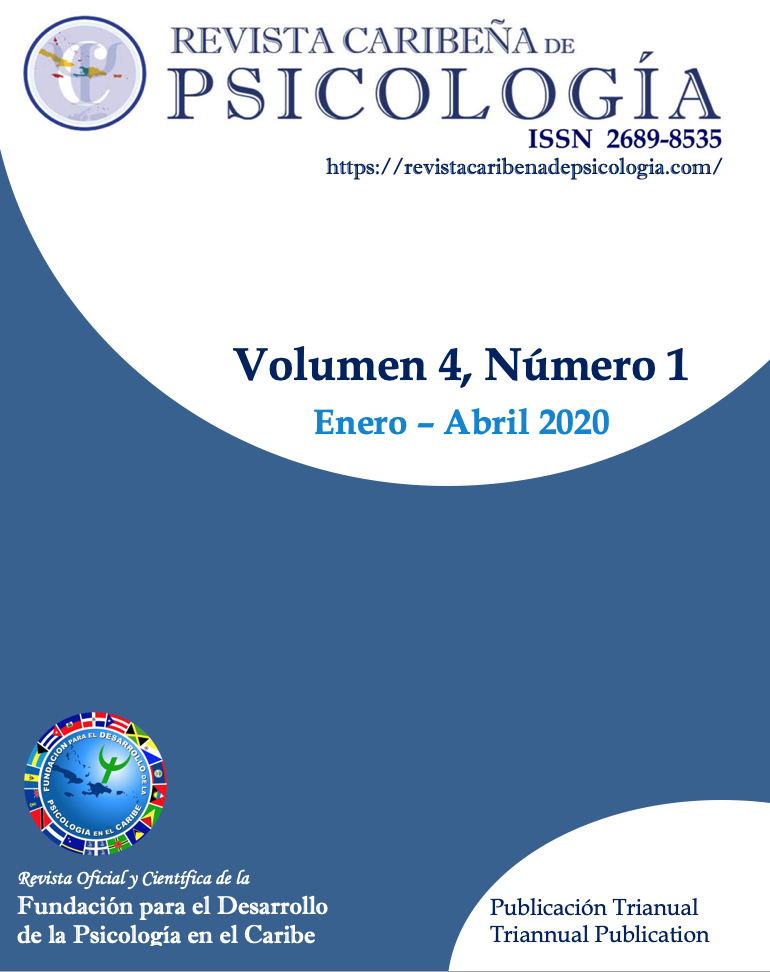Desarrollo y Validación de la Escala de Ansiedad por Enfermedad en Puerto Rico
DOI:
https://doi.org/10.37226/rcp.v4i1.1891Palabras clave:
ansiedad por enfermedad, confiabilidad, propiedades psicométricas, validaciónResumen
El presente estudio analiza las propiedades psicométricas de la Escala de Ansiedad por Enfermedad en una muestra de adultos puertorriqueños. Un total de 300 puertorriqueños participaron en este estudio de carácter exploratorio y psicométrico. Los resultados confirmaron que la escala posee una estructura unidimensional. Los 10 ítems de la escala cumplieron con los criterios de discriminación. El índice de confiabilidad alfa de Cronbach de la escala fue .95. Estos resultados sugieren que el instrumento tiene el potencial para medir este constructo en adultos puertorriqueños. Además, la escala permitirá el avance de nuevas investigaciones sobre la ansiedad por enfermedad en adultos puertorriqueños, caribeños y latinoamericanos.
Citas
Abramowitz, J., Schwartz, S., & Whiteside, S. (2002). A contempo-rary conceptual model of hypochondriasis. Mayo Clinic Proceedings, 77(12), 1323-1330. https://doi.org/10.4065/77.12.1323
American Psychiatric Association, DSM-5 Task Force. (2013). Diagnostic and statistical manual of mental disorders: DSM-5™ (5th ed.). American Psychiatric Publishing, Inc. https://doi.org/10.1176/appi.books.9780890425596
Ato, M., López, J. J., & Benavente, A. (2013). Un sistema de clasificación de los diseños de investigación en psicología. Anales de Psicología, 29(3), 1038-1059. http://dx.doi.org/10.6018/ana-lesps.29.3.178511
Bailer, J., Kerstner, T., Witthöft, M., Diener, C., Mier, D., & Rist, F. (2016). Health anxiety and hypochondriasis in the light of DSM-5. Anxiety, Stress, and Coping, 29(2), 219-239. https://doi.org/10.1080/10615806.2015.1036243
Barsky, A. J., Fama, J. M., Bailey, E. D., & Ahern, D. K. (1998). A prospective 4- to 5-year study of DSM-III-R Hypochondriasis. Archives of General Psychiatry, 55(8), 737–744. https://doi.org/10.1001/archpsyc.55.8.737
Barsky, A. J., Orav, E., & Bates, D. (2005). Somatization increase medical utilization and cost independent of psychiatric and medical comorbidity. Archives of General Psychiatric 62(8), 903-910. https://doi.org/10.1001/archpsyc.62.8.903
Brakoulias, V. (2014). DSM-5 bids farewell to hypochondriasis and welcomes somatic symptom disorder and illness anxiety dis-order. Australian & New Zealand Journal of Psychiatry, 48(7), 688–688. https://doi.org/10.1177/0004867414525844
Field, A. P. (2013). Discovering statistics using IBM SPSS Statistics (4ª. ed.). SAGE.
Fink, P., Ørnbøl, E., & Christensen, K. S. (2010). The outcome of health anxiety in primary care: A two-year follow-up study on health care costs and self-rated health. PLoS ONE, 5(3). Article e9873. https://doi.org/10.1371/journal.pone.0009873
IBM Corporation. (2016). IBM SPSS Statistics for Windows (Version 24.0) [Software]. IBM.
Jung, S. (2013). Exploratory factor analysis with small sample sizes: A comparison of three approaches. Behavioural Processes, 97(1), 90-95. https://doi.org/10.1016/j.beproc.2012.11.016
Kline, P. (2000). Handbook of psychological testing. Routledge.
Kline, T. J. (2005). Psychological testing: A practical approach to design and evaluation. Sage.
Lloret-Segura, S., Ferreres-Traver, A., Hernández-Baeza, A., & To-más-Marco, I. (2014). El análisis factorial exploratorio de los ítems: Una guía práctica, revisada y actualizada. Anales de Psi-cología, 30(3), 1151-1169. http://dx.doi.org/10.6018/ana-lesps.30.3.199361
López-Solà, C., Bui, M., Hopper, J., Fontenelle, L., Davey, C., Pantelis, C., Alonso, P., Heuvel, O., & Harrison, B. (2018). Predictors and consequences of health anxiety symptoms: a novel twin modeling study. Acta Psychiatrica Scandinavica, 137(3), 241–251. https://doi.org/10.1111/acps.12850
Lucock, M. & Morley, S. (1996). The Health Anxiety Scale. British Journal of Health Psychology, 1(2), 137-150. https://doi.org/10.1111/j.2044-8287.1996.tb00498.x
McManus, F., Leung, C., Muse, K., & Williams, J. (2014). Under-standing Cyberchondria: an interpretive phenomenological analysis of the purpose, methods and impact of seeking health information online for those with health anxiety. The Cognitive Behavior Therapist, 7(e21), 1-13. https://doi.org/10.1017/S1754470X14000270
Montero, I., & León, O. G. (2007). A guide for naming research stu¬dies in psychology. International Journal of Clinical and Health Psychology, 7(3), 847-862. https://www.re-dalyc.org/pdf/337/33770318.pdf
Mykletun, A., Heradstveit, O., Eriksen, K., Glozier, N., Øverland, S., Mæland, J. G., & Wilhelmsen, I. (2009). Health anxiety and disability pension award: The HUSK study. Psychosomatic Medicine, 71(3), 353–360. https://doi.org/10.1097/PSY.0b013e31819cc772
Rachman, S. (2012). Health anxiety disorders: A cognitive con-strual. Behavior Research and Therapy, 50(7-8), 502-512. https://doi.org/10.1016/j.brat.2012.05.001
Rodríguez-Testal, J. F., Sanín-Calderón, C., & Perona-Garcelán, S. (2014). From DSM-IV-TR to DSM-5: Analysis of some changes. International Journal of Clinical and Health Psychology, 14(3), 221-223. http://dx.doi.org/10.1016/j.ijchp.2014.05.002
Salkovskis, P., & Warwick, H. (2001). Making sense of hypochon-driasis: A cognitive model of health anxiety. In G. J. G. As-mundson, S. Taylor, & B. J. Cox (Eds.), Health anxiety: Clinical and research perspectives on hypochondriasis and related conditions (pp. 47-64). John Wiley & Sons.
Salkovskis, P., Rimes, K., Warwick, H., & Clark, D. (2002). The health anxiety inventory: Development and validation of scales for the measurement of health anxiety and hypochon-driasis. Psychological Medicine, 32(5), 843–853. https://doi.org/10.1017/s0033291702005822
Schmitt, T. A. (2011). Current methodological considerations in ex¬ploratory and confirmatory factor analysis. Journal of Psychoeducational Assessment, 29(4), 304-321. https://doi.org/10.1177/0734282911406653
Spitzer, R. L., Kroenke, K., Williams, J. B. W. & Löwe, B. (2006). A brief measure for assessing generalized anxiety disorder: The GAD-7. Archives of Internal Medicine, 166(10), 1092-1097. https://doi.org/10.1001/archinte.166.10.1092
Stevens, J. (2002). Applied multivariate statistics for the social sciences (4ª. ed.). Lawrence Erlbaum.
Taylor, R. (1990). Interpretation of the correlation coefficient: A basic review. Journal of Diagnostic Medical Sonography, 6(1), 35-39. https://doi.org/10.1177/875647939000600106
Torales, J. (2017). ¡Ayúdeme doctor, estoy muy enfermo! Una actualización de la clásica hipocondría al vigente trastorno de ansiedad por enfermedad. Revista Virtual de la Sociedad Paraguaya de Medicina Interna, 4(1), 77-86. http://dx.doi.org/10.18004/rvspmi/2312-3893/2017.04(01)77-086
Wilson, F. R., Pan, W., & Schumsky, D. A. (2012). Recalculation of the critical values for Lawshe’s content validity ratio. Measurerment and Evaluation in Counseling and Development, 45(3), 197-210. https://doi.org/10.1177/0748175612440286
Witthöft, M., Mier, D., Ofer, J., Müller, T., Rist, F., Kirsch, P., Bailer, J., & Diener, C. (2013). Neuronal and Behavioral Correlates of Health Anxiety: Results of an Illness-Related Emotional Stroop Task. Neuropsychobiology, 67(2), 93-102. https://doi.org/10.1159/000345545
Yates, W. (2014). Somatic symptom disorders: Background, pathophys-iology, epidemiology. https://emedicine.medscape.com/article/294908-overview







